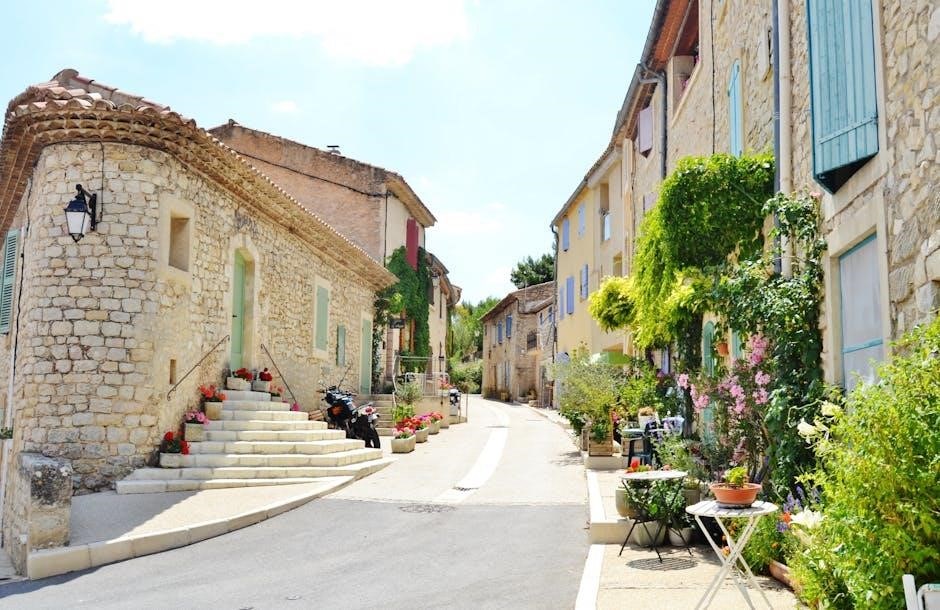La Casa en Mango Street: An Overview
La Casa en Mango Street, by Sandra Cisneros, presents Esperanza Cordero, a young Latina girl navigating adolescence in Chicago. The novel explores her dreams, struggles against poverty, and search for identity within her community.
Sandra Cisneros’s La Casa en Mango Street, published in 1984, employs a series of vignettes to narrate Esperanza Cordero’s coming-of-age. Esperanza, a young Chicana girl in Chicago, grapples with identity, discrimination, and the desire to escape her impoverished neighborhood. The novel’s cultural significance stems from its portrayal of Chicana experiences, exploring themes of poverty, racism, and female empowerment. Through Esperanza’s journey, Cisneros invites readers to reflect on the challenges faced by marginalized communities and the pursuit of dreams against societal constraints. The novel’s accessibility and poignant storytelling have made it a staple in literature.
Esperanza Cordero: A Coming-of-Age Story
Esperanza Cordero’s story is about adolescence in Chicago, exploring her dreams, struggles, and evolving identity. She confronts social expectations, poverty, and cultural challenges as she matures on Mango Street.
Esperanza’s Dreams and Aspirations
Esperanza dreams of escaping Mango Street’s poverty and limitations, yearning for a home of her own. She aspires to be a writer, using her voice to tell stories and break free from societal constraints. Central to her aspirations is a desire for independence and self-definition. Esperanza envisions a future where she can empower herself and other women, challenging traditional roles. She seeks to find beauty and strength in her cultural identity, transforming her experiences into art, and inspiring change within her community. Her dreams are fueled by a deep desire for a better life, marked by freedom and creativity.
Mango Street: Setting and Symbolism
Mango Street symbolizes poverty, identity, and the challenges faced by the Chicana community. It represents a place of both confinement and cultural richness, shaping Esperanza’s understanding of herself and her world.
The House as a Representation of Poverty and Identity
The house on Mango Street, a small, red house in a humble neighborhood, falls short of Esperanza’s dreams. It symbolizes the economic struggles of her family and the broader community. It’s a far cry from the white house with space she imagined. Despite its shortcomings, the house becomes intertwined with Esperanza’s evolving sense of self. It highlights the challenges she faces due to her background. The house also represents a place from which Esperanza desires to escape, linking it to her aspirations for a better future and a stronger identity beyond Mango Street.
Key Characters and Their Influence
Esperanza interacts with characters like Marin, Sally, and Elenita, who shape her perspectives on womanhood, relationships, and societal expectations within her marginalized community. They influence her journey of self-discovery.
Marin, Sally, and Elenita: Shaping Esperanza’s Perspective
Marin, an older girl, offers a glimpse into the world of romance and longing for escape through marriage. Sally’s experiences highlight the complexities of female relationships and the dangers of male dominance. Elenita, the fortune teller, provides a spiritual perspective, urging Esperanza to find strength within herself. These characters collectively contribute to Esperanza’s understanding of womanhood and her evolving sense of self. Each encounter teaches her valuable lessons about survival, resilience, and the importance of forging her own path. They act as mirrors, reflecting different aspects of Esperanza’s potential future and shaping her determination to define her own destiny beyond Mango Street.
Themes of Identity and Discrimination
The House on Mango Street delves into identity, exploring how Esperanza grapples with her Chicana heritage amid poverty and societal expectations. Discrimination is shown through the challenges faced by marginalized communities.
Exploring the Challenges Faced by Marginalized Communities
Sandra Cisneros’s novel sheds light on the hardships endured by marginalized communities, particularly Mexican-American women, within impoverished neighborhoods. Esperanza’s experiences reflect broader issues of racism, sexism, and economic inequality prevalent in her surroundings. The characters encounter limitations in education, employment, and overall opportunities due to their ethnicity and socioeconomic status. The novel highlights the importance of resilience and empowerment in overcoming these challenges. Esperanza’s desire to escape Mango Street symbolizes the yearning for a better life and a rejection of the oppressive circumstances that confine her and others. Ultimately, the story serves as a call to action for social justice.
The Structure of the Novel: Vignettes
The House on Mango Street is structured as a series of vignettes, short and evocative narratives. These fragments capture moments in Esperanza’s life, creating a mosaic of her experiences and growth.
Short Narratives and Their Impact on Storytelling
The short, vignette-style narratives in The House on Mango Street provide snapshots of Esperanza’s life and the lives of those around her. Each vignette functions as a small, focused story, contributing to the overall narrative tapestry. This structure allows Cisneros to explore various themes, such as identity, poverty, and gender roles, with brevity and impact. These individual narratives create a powerful and intimate portrayal of Esperanza’s coming-of-age in a marginalized community, offering a unique and poignant reading experience through their concise storytelling.

Literary Analysis: Style and Language
Cisneros employs vivid imagery and symbolism in The House on Mango Street. Her poetic prose creates a rich tapestry that reflects Esperanza’s experiences and the cultural landscape of Mango Street.
Cisneros’s Use of Imagery and Symbolism
Sandra Cisneros masterfully utilizes imagery and symbolism throughout The House on Mango Street to enhance the story’s emotional depth and thematic resonance. The house itself symbolizes Esperanza’s longing for a true home and a sense of belonging. Hair, a recurring image, represents identity and individuality. The girls and women in Esperanza’s community embody different paths and possibilities, shaping her understanding of womanhood. Cisneros’s use of these literary devices creates a vivid and evocative portrayal of Esperanza’s world, inviting readers to delve deeper into the story’s layers of meaning, exploring themes of identity, poverty, and empowerment.

Cultural Significance and Impact
The House on Mango Street holds significant cultural value, portraying the Chicana experience with authenticity. It highlights themes of identity, discrimination, and female empowerment, fostering reflection on marginalized communities’ challenges and the pursuit of personal dreams.
The Novel’s Portrayal of Chicana Identity
Cisneros’s novel offers a poignant portrayal of Chicana identity through Esperanza’s experiences. Growing up in a Chicago barrio, Esperanza grapples with issues of cultural heritage, language, and societal expectations. The book explores the complexities of being a Mexican-American girl, navigating the intersection of two distinct worlds. Esperanza’s story reflects the challenges faced by many young Chicanas as they strive to define themselves, embracing their roots while seeking opportunities for personal growth and independence. The novel delves into the unique struggles and triumphs associated with Chicana identity, resonating with readers who share similar experiences or seek to understand them.

The Search for a Home and Belonging
Esperanza Cordero longs to escape Mango Street, seeking a place where she truly belongs. Her journey explores the universal desire for a home that reflects her identity and aspirations.
Esperanza’s Desire to Escape Mango Street
Esperanza’s yearning to leave Mango Street is a central theme, fueled by her discontent with poverty and limited opportunities. She dreams of a house that is truly her own, a sanctuary where she can express her identity without the constraints of her current environment. Mango Street represents not just a physical location, but also the societal and cultural limitations that Esperanza seeks to overcome. Her desire for escape is intertwined with her ambition to break free from the cycle of poverty and create a better future for herself, fueled by hope and determination.

Empowerment and the Future
Esperanza’s journey culminates in self-discovery and empowerment, paving the way for a future where she defies limitations. Her experiences on Mango Street shape her resolve to achieve independence and create a better life.
Esperanza’s Journey Towards Self-Discovery and Independence
La Casa en Mango Street portrays Esperanza’s evolution as she confronts societal constraints and personal challenges. Through interactions with characters like Marin, Sally, and Elenita, she gains insights into womanhood and the limitations imposed on women within her community. Esperanza’s desire to escape Mango Street fuels her pursuit of self-discovery, using writing as a tool for expression. Ultimately, Esperanza embarks on a path towards independence, aspiring to break free from the cycle of poverty and create a future where she can define her own identity and destiny, becoming a writer who tells stories.



